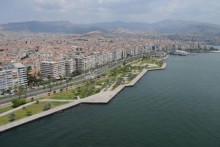


Izmir, formerly Smyrna, city and seaport in western Turkey, capital of Izmir Province, at the head of the Gulf of Izmir. Izmir is one of the chief seaports of Turkey and is served by several railroads.
It is also a commercial and industrial center; dyes, soaps, and textiles are manufactured and foods and tobacco are processed. The chief exports include carpets, foodstuffs, and minerals. Aegean University (1955) is here. Founded in the 11th century BC by the Aeolians, a Greek people, the city was seized by the Ionians before 688 BC. Later in the 7th century BC, Smyrna was devastated by the Lydians, a people of Asia Minor.
Antigonus I, king of Macedonia, restored the city in the 4th century BC, and subsequently it was fortified and improved by Lysimachus, a general in the service of Alexander the Great.
Smyrna was conquered later by the Romans and subsequently became an early center of Christianity, referred to as one of the "seven churches". During the 4th century AD the city was made a part of the Byzantine Empire, and from the 11th to the 15th century was alternately ruled by the Byzantines and the Turks. In 1402 Smyrna was ravaged by the Mongols under Tamerlane, and after 1424 belonged to the Ottoman Turks. The Greeks claimed Smyrna after World War I (1914-1918), and by the terms of the Treaty of Sèvres, drawn up in 1920, the administration of the city and its Ionian hinterland was assigned to Greece for five years. The Greek occupation was contested by the Turks, who seized Smyrna in 1922. According to the provisions of the Treaty of Lausanne in 1923, the city was awarded to Turkey.